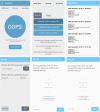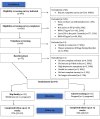Slip Buddy App for Weight Management: Randomized Feasibility Trial of a Dietary Lapse Tracking App
- PMID: 33792547
- PMCID: PMC8050748
- DOI: 10.2196/24249
Slip Buddy App for Weight Management: Randomized Feasibility Trial of a Dietary Lapse Tracking App
Abstract
Background: Although calorie tracking is one of the strongest predictors of weight loss in behavioral weight loss interventions, low rates of adherence are common.
Objective: This study aims to examine the feasibility and acceptability of using the Slip Buddy app during a 12-week web-based weight loss program.
Methods: We conducted a randomized pilot trial to evaluate the feasibility and acceptability of using the Slip Buddy app compared with a popular commercial calorie tracking app during a counselor-led, web-based behavioral weight loss intervention. Adults who were overweight or obese were recruited on the web and randomized into a 12-week web-based weight loss intervention that included either the Slip Buddy app or a commercial calorie tracking app. Feasibility outcomes included retention, app use, usability, slips reported, and contextual factors reported at slips. Acceptability outcomes included ratings of how helpful, tedious, taxing, time consuming, and burdensome using the assigned app was. We described weight change from baseline to 12 weeks in both groups as an exploratory outcome. Participants using the Slip Buddy app provided feedback on how to improve it during the postintervention focus groups.
Results: A total of 75% (48/64) of the participants were female and, on average, 39.8 (SD 11.0) years old with a mean BMI of 34.2 (SD 4.9) kg/m2. Retention was high in both conditions, with 97% (31/32) retained in the Slip Buddy condition and 94% (30/32) retained in the calorie tracking condition. On average, participants used the Slip Buddy app on 53.8% (SD 31.3%) of days, which was not significantly different from those using the calorie tracking app (mean 57.5%, SD 28.4% of days), and participants who recorded slips (30/32, 94%) logged on average 17.9 (SD 14.4) slips in 12 weeks. The most common slips occurred during snack times (220/538, 40.9%). Slips most often occurred at home (297/538, 55.2%), while working (153/538, 28.4%), while socializing (130/538, 24.2%), or during screen time (123/538, 22.9%). The conditions did not differ in participants' ratings of how their assigned app was tedious, taxing, or time consuming (all values of P>.05), but the calorie tracking condition gave their app higher helpfulness and usability ratings (all values of P<.05). Technical issues were the most common type of negative feedback, whereas simplicity was the most common type of positive feedback. Weight losses of ≥5% of baseline weight were achieved by 31% (10/32) of Slip Buddy participants and 34% (11/32) of calorie tracking participants.
Conclusions: Self-monitoring of dietary lapses and the contextual factors associated with them may be an alternative for people who do not prefer calorie tracking. Future research should examine patient characteristics associated with adherence to different forms of dietary self-monitoring.
Trial registration: ClinicalTrials.gov NCT02615171; https://clinicaltrials.gov/ct2/show/NCT02615171.
Keywords: diet; mHealth; mobile app; mobile phone; obesity; weight loss.
©Sherry Pagoto, Bengisu Tulu, Molly E Waring, Jared Goetz, Jessica Bibeau, Joseph Divito, Laurie Groshon, Matthew Schroeder. Originally published in JMIR mHealth and uHealth (http://mhealth.jmir.org), 01.04.2021.
Conflict of interest statement
Conflicts of Interest: SP is a paid scientific advisor for Fitbit and has been a paid consultant for WW.
Figures
References
-
- Overweight and obesity. National Heart Lung and Blood Institute. [2018-02-15]. https://www.nhlbi.nih.gov/health-topics/overweight-and-obesity.
-
- Burke LE, Wang J, Sevick MA. Self-monitoring in weight loss: a systematic review of the literature. J Am Diet Assoc. 2011 Jan;111(1):92–102. doi: 10.1016/j.jada.2010.10.008. http://europepmc.org/abstract/MED/21185970 - DOI - PMC - PubMed
Publication types
MeSH terms
Associated data
Grants and funding
LinkOut - more resources
Full Text Sources
Other Literature Sources
Medical



